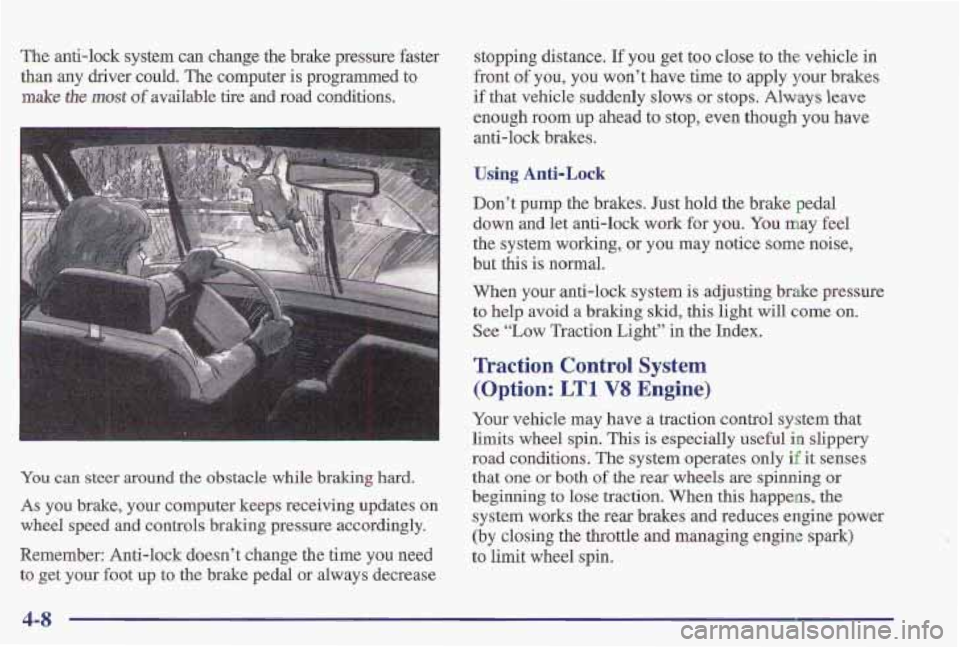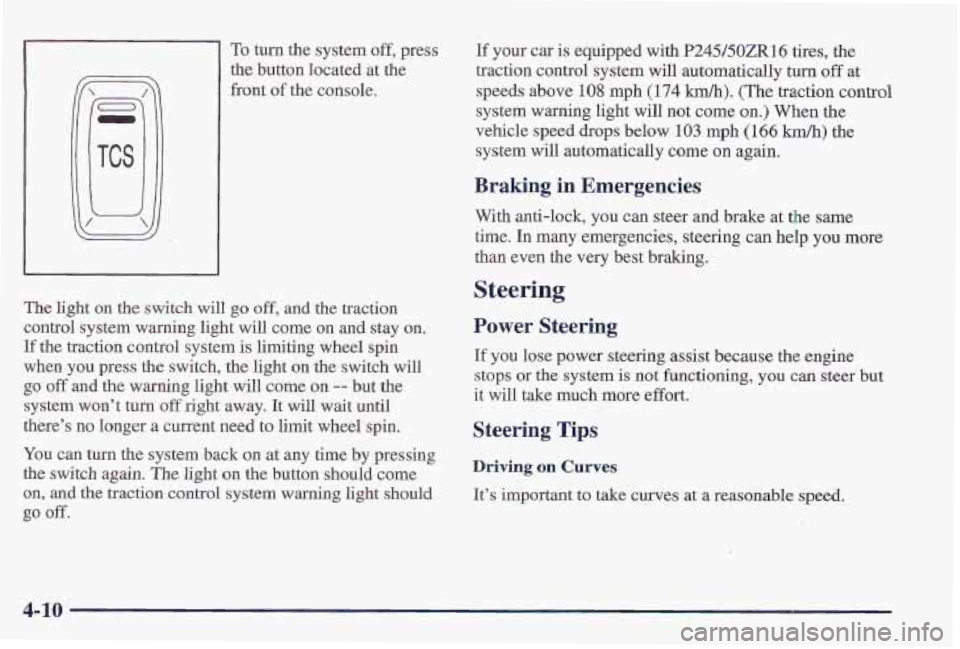1997 PONTIAC FIREBIRD traction control
[x] Cancel search: traction controlPage 85 of 410

Shift Speeds
If pull skip more than one gear waien you
downshift, you could lose control of your vehicle.
And
you could injure yourself or others. Don’t
shift from SIXTH (6) to THIRD (3), or FIFTH (5:
to SECOND (2) or FOURTH (4) to FIRST (1).
This chart shows when to shift to the next higher gear
for best fuel economy.
I MANUAL TRANSMISSION RECOMMENDED SHIFT SPEEDS, IN MPH (kmfh) ,
Engine Acceloratlen Shlft Speed
it02 I 2to3 I 3to4 I 4to5 I St06
(72-75) I N’A 45-47
If your speed drops below 20 mph (30 km/h), or if the
engine is
not running smoothly, you should downshift to
the next lower gear. You may have to downshift two or
more gears to keep the engine running smoothly or for
good performance.
Limited-Slip Rear Axle
If you have this feature, your rear axle can give you
additional traction on snow, mud, ice, sand or gravel. It
works like
a standard axle most of the time, but when
one
of the rear wheels has no traction and the other does,
the limited-slip locking feature will allow the wheel
with traction to move the vehicle.
2-36
Page 97 of 410

Cruise control can be dangerous where you
can’t drive safely at
a steady speed. So,
don’t use your cruise control on winding
roads or in heavy traffic.
slippery roads. On such roads, fast changes
in tire traction can cause needless wheel
spinning, and you cauld lose control. Don’t
use cruise control on slippery roads.
0 Cruise control ‘can be dangerous on
If your vehicle is in cruise control when the optional
traction control system begins to limit wheel spin,
the
cruise control will automatically disengage. (See
“Traction Control System” in the Index.) When road
conditions allow you to safely use it again, you may turn
the cruise control
back on.
Setting Cruise Control
~ ~~~
If you leave your cruise control switch on when
you’re not using cruise, you might
hit a button and
go into cruise when you don’t want to. You could
be startled and even lose control. Keep the cruise
control switch OFF until you want to use it.
2-48
Page 124 of 410

A. Fog Lamp Switch (If Equipped)
B. Main Lamp Control
C. Air Vent
D. Instrument Cluster
E.
Horn
E Audio System
G. Glove Box
H. Comfort Controls
I. Cupholder
J. Parking Brake Lever
K.
Storage Console
L. Rear Window Defogger Switch
M. Convertible Top Switch (Automatic) (If Equipped)
N. Traction Control System Switch or Second Gear
0. Cigarette Lighter
P. Shift Lever
Q. Ashtray (Automatic Transmission)
R. Convertible Top Switch (Manual) (If Equipped)
S. Steering Wheel Controls
T. Remote Hatch Release
Start
Switch (If Equipped)
Page 130 of 410

Traction Control System Warning Light
(If Equipped)
I
Your regular brake system may not be working
properly if the anti-lock brake system warning
light is flashing. Driving with the anti-lock
brake system warning light flashing can lead to
an accident. After you’ve pulled off the road
and stopped carefully, have the vehicle towed
for service.
If the anti-lock brake system warning light stays on
longer than normal after you’ve started your engine, turn
the ignition off. Or, if the light comes on and stays on
when you’re driving, stop as soon as possible and turn
the ignition off. Then start the engine again to reset the
system.
If the light still stays on, or comes on again
while you’re driving, your Pontiac needs service. If the
light is on but not flashing and the regular brake system
warning light isn’t on, you still have brakes, but you
don’t have
anti-lock brakes.
The anti-lock brake system warning light should come
on briefly when you turn the ignition key to RUN. If the
light doesn’t come on then, have it fixed so it will be
ready to warn you if there is a problem.
TCS
OFF
This warning light should
come on briefly as you start
the engine.
If the. warning
light doesn’t come on then,
have it fixed
so it will be
ready to warn you if there’s
a problem.
If it stays on, or comes on when you’re driving, there
may be a problem with your traction control system and
your vehicle may need service. When this warning light
is on, the system will not limit wheel spin. Adjust your
driving accordingly.
If your brakes begin to overheat, the brake portion of the
traction control system will shut down, but the throttle
and engine spark control will continue
to work. The
warning light will not come on when this happens.
Page 131 of 410

The traction control system warning light may come on
for the following reasons:
If you turn the system off by pressing the switch
located at the front
of the console the warning light
will come on and stay on and the light on the switch
will
go out. To turn the system back on, press the
switch again. The warning light should go off.
(See “Traction Control System” in the Index
for more information.)
If the temperature of the throttle control b’egins to
rise, the system will turn off and the warning light
will come
on until the system cools down. The
system does this to prevent damage from
overheating.
If the traction control system warning light comes on
and stays on for an extended period
of time when the
system
is turned on, your vehicle needs service.
Low Traction Light
When your anti-lock system
is adjusting brake pressure
to help avoid
a braking skid,
this light will come on.
LOW
TRAC
If you have the traction control system, this light will
also come
on when the system is limiting wheel spin.
Slippery road conditions may exist if the low traction
light comes on,
so adjust your driving accordingly. The
light will stay on for a few seconds after the anti-lock
system stops a’djusting brake pressure or the traction
control system stops limiting wheel spin.
The low traction
light also comes on briefly when you
turn the ignition
key to RUN. If the light doesn’t come
on then, have
it fixed so it will be there to tell you when
the anti-lock brake system or traction control system
is active.
2-82
Page 173 of 410

The anti-lock system can change the brake pressure faster
than any driver could. The computer is programmed to
make the most of available tire and road conditions.
You can steer around the obstacle while braking hard.
As you brake, your computer keeps receiving updates on
wheel speed and controls braking pressure accordingly.
Remember: Anti-lock doesn’t change the time
you need
to get your foot up to the brake pedal or always decrease stopping distance.
If you
get too close to the vehicle in
front
of you, you won’t have time to apply your brakes
if that vehicle suddenly slows or stops. Always leave
enough room up ahead to stop, even though you have
anti-lock brakes.
Using Anti-Lock
Don’t pump the brakes. Just hold the brake pedal
down and let anti-lock work for you.
You may feel
the system working, or you may notice some noise,
but this is normal.
When your anti-lock system
is adjusting brake pressure
to help avoid a
braking skid, this light will come on.
See
“Low Traction Light” in the Index.
Traction Control System
(Option: LTI V8 Engine)
Your vehicle may have a traction control system that
limits wheel spin. This
is especially useful in slippery
road conditions. The system operates only
if it senses
that one or
both of the rear wheels are spinning or
beginning to lose traction. When this happens,
the
system works the rear brakes and reduces engine power
(by closing the throttle and managing engine spark)
to limit wheel spin.
Page 174 of 410

LOW
TRAC
This light will come on
when your traction control
system is limiting wheel
spin. See “Low Traction
Light” in the Index.
You
may feel or hear the system
working, but this is normal.
TCS
OFF
When the system is on,
this warning light will
come on to let you how
if
there’s a problem with your
traction control. system.
See “Traction Control
System Warning Light”
in the Index.
The traction control system may operate on dry roads
under some conditions, and you may notice a reduction
in acceleration when this happens. This is normal and
doesn’t mean there’s a problem with your vehicle.
Examples of these conditions include a hard acceleration
in
a turn, or an abrupt upshift or downshift. Also, when
the compact spare tire is on
the rear axle, the traction
control system will cycle and limit acceleration for about
the first 15 seconds of driving after each engine start.
If your vehicle is in cruise control when the traction
control system begins to limit wheel spin, the cruise
control will automatically disengage. When road
conditions allow you to safely use it again, you may
re-engage the cruise control. (See “Cruise Control’’ in
the Index.)
When this warning light is on, the system will not limit
wheel spin. Adjust your driving accordingly.
The traction control system automatically comes on
whenever you start your vehicle.
To limit wheel spin,
especially in slippery road conditions, you should
always leave the system on. But you can turn the
traction control system off
if you ever need to. (You
should turn the system off if your vehicle ever gets stuck
in sand, mud,
ice or snow. See “Rocking Your Vehicle”
in the Index.)
4-9
Page 175 of 410

To turn the system off, press
the button located at the
front
of the console.
The light on
the switch will go off, and the traction
control system warning light will come on and stay on.
If the traction control system is limiting wheel spin
when
you press the switch, the light on the switch will
go off and the warning light will come on -- but the
system won’t turn
off right away. It will wait until
there’s
no longer a current need to limit wheel spin.
You can turn the system back on at any time by pressing
the switch again. The light
on the button should come
on, and the traction control system warning light should
go off. If
your car is equipped with P245/5OZR16 tires, the
traction control system will automatically turn
off at
speeds above 108 mph
(174 km/h). (The traction control
system warning light will not come on.) When the
vehicle speed drops below
103 mph (166 kmh) the
system will automatically come on again.
Braking in Emergencies
With anti-lock, you can steer and brake at the same
time.
In many emergencies, steering can help you more
than even the very best braking.
Steering
Power Steering
If you lose power steering assist because the engine
stops or the system is not functioning, you can steer but
it will take much more effort.
Steering Tips
Driving on Curves
It’s important to take curves at a reasonable speed.
4- 10